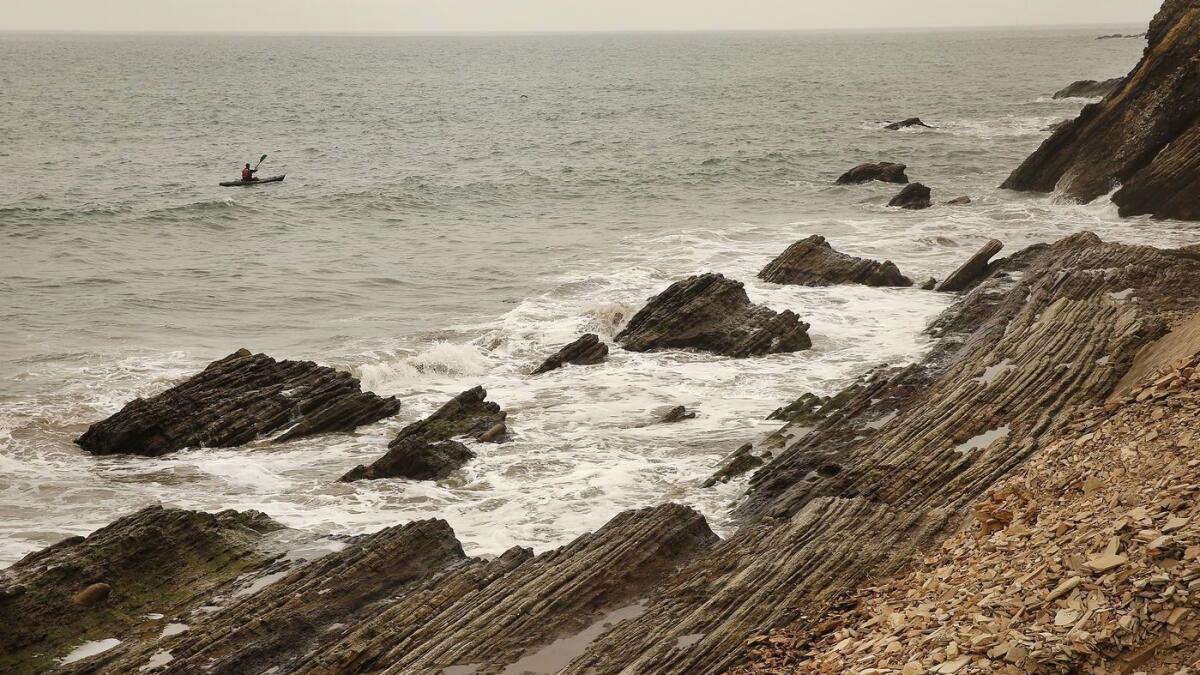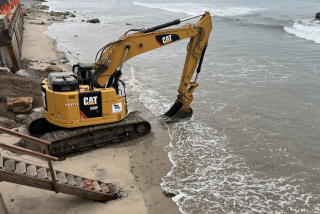Column: Hollister Ranch access agreement is a wipeout and a sellout, hundreds of beach lovers scream

Just in time for the start of summer, a new skirmish in an old fight for beach access has broken out in California, where people don’t let anyone kick sand in their faces without kicking back.
Steady as the pounding surf, hundreds of emails have crashed ashore at the California Coastal Commission, sent by residents protesting a recent agreement that strictly limits public access to the beach at Hollister Ranch on the Gaviota Coast.
“I am a 13-year-old boy who enjoys surfing and junior guards,” wrote Marty Walsh, who asked commissioners to preserve access “for my future kids and grandchildren.”
“I am writing to express my shock, alarm and complete resistance to the pending settlement,” wrote Topanga resident Karen Roberts, who railed against the clout of Hollister Ranch celebs and other residents who have resisted public access for decades.
“This is money talking, this is prestige talking, this is people in Hollister Ranch who think they are so special that who no one can share the area they live in,” wrote Roberts, who warned of a dangerous precedent if the deal is not amended. “This is not California talking.”
As of mid-week, about 600 emails had been sent to Hollister@coastal.ca.gov, and the tally was not close.
All but three of them protested the settlement reached by the Coastal Commission and the Hollister Ranch Owners Assn.
Writers sent tales of lifelong love affairs with warm sand, cool water and ocean breezes. Many voiced their unwavering support of California’s landmark Coastal Act, which established strict rules governing preservation and access and enshrined the ideal that in California, the coast is a public treasure, not a private playground.
“The California coast is for everyone,” wrote Guy Cumberbatch of Santa Barbara, an attorney who called for a fairer compromise between the rights of private property owners and those who aren’t lucky enough to live near the beach. “Let’s not essentially shut down a huge and scenic stretch of it for the benefit of millionaires. Please rethink this settlement which provides meager crumbs to the public.”
While the torpedoes landed, representatives of several nonprofits discussed possible legal intervention in an attempt to fight for greater access. This was made possible by Santa Barbara County Judge Colleen Stern, who recognized that “the settlement abandons disputed rights of public access,” and said “a full inquiry into the fairness of the settlement” can be held before final approval.
This is money talking, this is prestige talking, this is people in Hollister Ranch who think they are so special that who no one can share the area.
— Karen Roberts, Topanga resident
Marc Chytilo, a lawyer with the Gaviota Coast Conservancy, said one option might be to rally for a scuttled 1981 plan to provide access by foot, bicycle and shuttle.
All this scrambling began with a May 22 scoop by my colleague Rosanna Xia, who covers the coast. She dug out the terms of the deal with homeowners, in which the Coastal Commission and the Coastal Conservancy gave up a long-disupted public access route by land in return for a couple of concessions. Those include the expansion of an after-school tide pool program and organized tours for nonprofit groups that would give access to about 400 people a year.
The third concession involves access to a skimpy three-quarter mile stretch of the more than 8-mile Hollister coastline to those willing to brave the often treacherous conditions and paddle in from two miles away. Chytilo, by the way, knows the area and said depending on tides, that particular beach might be half under water.
Hollister’s invitation for us to risk our lives was the topic of my column last Sunday. I was ready to paddle, but I was warned not to go by kayak without a professional guide, because I wouldn’t be the first sailor blown out to sea or caught in killer currents on that breezy stretch of coast.
“A few times we really feared for our lives,” said reader Jan Clover, who wrote to tell me about surfing excursions with her boyfriend in the 1970s. Even in a boat, she said, you could be in trouble in a hurry.
“The weather would seem good, then suddenly that off-shore wind would come up 50 or 60 miles per hour, and if your motor conked out, it really was life-threatening,” Clover said. “How well I remember sprawling over the side of the boat holding on to an armful of kelp to keep us close to shore while he worked on the motor.”
The decision to settle the case was made after private legal wrangling, with the state attorney general’s office doing the negotiating for the state. Commissioners voted in closed session to approval the deal.
“The commission is basically saying, ‘We can’t tell you why we think we had to settle, but we had good reasons, and you have to trust that the public interest was best served by this settlement,’” said former Coastal Commission lawyer Ralph Faust.
But we’ve had plenty of good reasons not to trust the process, and to be on guard against the clout of developers, land owners and their high-powered lobbyists.
Exhibit A is the case against two current commissioners (Mark Vargas and Erik Howell) and three former commissioners (Martha McClure, Steve Kinsey and Wendy Mitchell) brought by Spotlight on Coastal Corruption. The nonprofit alleged multiple violations of rules on the reporting of private conversations with people involved in matters pending before the commission.
The state lawyers for the commissioners argued that many of the violations were mere oversights and partly attributable to sloppy administration. If so, you have to wonder why the other commissioners seemed to have no trouble playing by the rules.
In the end, a San Diego County judge levied fines against all five commissioners, ranging from $30,300 to $2,600. Still to be determined is who will pay the fines, and the legal fees, which are likely to be far greater.
Will it be the individual commissioners who broke the rules?
Or will it be the commission?
If it’s the latter, that means you and I pay, and the tax dollars that are used would be pulled from a tight budget that protects the coast and serves us all.
In a way, Hollister and Spotlight are connected, and both pose the first real test of a mostly reconstituted and improved Coastal Commission, thanks to the departure of a few skunks. Both cases are about transparency and public trust.
Legally, I don’t think the commissioners can back out of the Hollister agreement at this point. What they can do, at the July hearing near Santa Cruz, is let the public roar, and maybe that will provide fodder for any intervening party that tries to cut a better deal in front of the Santa Barbara County judge.
Some have suggested that the settlement may have been the most practical outcome of a complicated set of legal entanglements and logistical challenges to beach access.
But it wasn’t worth it.
The better move would have been to conclude that so little was gained, it was worth continuing the fight for access by land, even if the odds of victory were slim.
This commission needs to declare that in complicated cases, it will err, if it must, on the side of the public.
“Beaches are not a luxury,” Roberts said in her email to the commission. Thanks to the Coastal Act of 1976, inspired by a public uprising over private beachfront development, beaches are a “democratic commons” that “bring people together as equals.”
Or so they should.
Read more of Steve Lopez’s work and follow him on Twitter @LATstevelopez.
More to Read
Sign up for Essential California
The most important California stories and recommendations in your inbox every morning.
You may occasionally receive promotional content from the Los Angeles Times.










